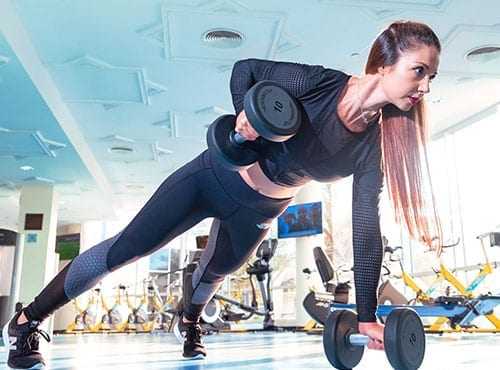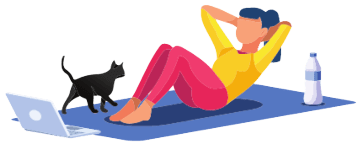Over the summer, I traveled to the coast of Maine to study at Anatomy Trains, a school dedicated to Structural Integration training for movement and manual therapists. While there, between eating lobster rolls and hiking the deep wooded paths along the Damariscotta River, I attended workshops on designing and implementing exercises for scoliosis and osteoporosis. Both scoliosis and osteoporosis are structural, bone-related disorders that can affect quality of life, posture, and ease of movement.
While in classes, my colleagues and I learned to use special tools and craft specific exercises from our instructor, Dr. Meredith Stephens, and she shared the newest research, all of which encouraged us. Best of all, we learned that quality of life, posture, and a greater ease of movement can be restored to anyone with either of these conditions by adding specific, well-implemented exercises to a daily training routine.

Today, let’s explore osteoporosis, and in my next column, I’ll delve into scoliosis.
Osteoporosis is a thinning and weakening of the bones and is characterized as a loss of bone quality and bone density. Anyone can have weakened bones due to lack of activity or a sedentary lifestyle, or through the aging process, or via secondary causes from disease, drugs, cancer, endocrine disorders, and malabsorption diseases. Osteoporosis, or osteopenia (low bone mass) are determined through a series of tests in an outpatient clinic setting. Commonly, DXA (Dual X-Ray Absorptiometry) is used, and it gives a bone mineralization, or density, score.
There’s another, newer test out there and I encourage you chat with your physician to see if she can order it for you. This test, a TBS (Trabecular Bone Score), gives a score of bone quality, the architecture of the bone. Keep in mind, though, a TBS must be performed at the same time as your DXA and can’t be used retroactively on a prior DXA test.
And there’s one more test you can do—it’s easy, and it’s done at home and online. It’s called the FRAX tool (Fracture Risk Assessment) and is used to assess your 10 year probability risk of fracture. You can take the test here: www.sheffield.ac.uk/FRAX/
Once you have your bone scores, what’s next?
Know this! There are lots of good things that can be done to improve quality of life. It’s about a combo of movement, diet, and lifestyle changes. Lace up and let’s learn.
Increase muscle mass through weight-lifting—haven’t you heard that resistance and strength training are the new elixirs of youth, and that adding in a routine of well-designed exercises improves your muscle mass. Pumping iron is by far one of the best “good things” you can do. Women in particular benefit from weight-lifting 2-3x per week. If you’ve been told that you’re high-risk, then chat with your doctor and make a plan of action, then find a skilled trainer who understands the implications and have her set a specific routine of weights for you.
Add functional exercise to your weekly schedule. Learn to move in ways that enhance daily activity—practice ground to standing exercises, add hip opening maneuvers, learn about postural awareness and work to improve your posture.
Twenty minutes of daily balance training. Have a skilled practitioner check your balance through a series of basic balance tests. Learn how to create better balance using exercises for your hips and lower legs, for your feet and for your abdominals.
Now, I want to mention walking. Since I’m advocating exercise as a means of improving vitality and creating a body better suited to carrying you through many more healthy decades, remember that walking as your only means of exercise is, unfortunately, not enough. To your walking routine, add some “good things” from all of the above: weight-training, functional moves, and balance work.

Other good things to include:
Improve your diet. Make sure you’re getting enough protein. Check that your mineral intake is adequate, especially calcium, magnesium, zinc, and others. And while you’re considering bone health and improving it through nutrition, it’s a perfect time to reduce or avoid sugars, sodas, excessive caffeine, and high-acid diets. Overall, try to eat a well-balanced diet. Avoid diets that cut out any food groups. Have your vitamin D levels checked to make sure your blood levels are satisfactory.
Add more impact. Did you know that you should be stomping your feet 50x a day? Make each footfall audible.
Have your vision checked. When we don’t see well, we’re more likely to trip and fall, or stumble, which may lead to a tumble.
Watch your alcohol intake.
If you’re a smoker, it’s a great time to stop. If you need help quitting, reach out.
Know that getting a diagnosis of osteoporosis is only that, a diagnosis. There are many things you can actively do to increase muscle mass, improve balance which reduces risk of falling, and create ease in your body. If you have osteoporosis, give these all a try and feel free to let me know how your quality of life is enhanced.

Good post. I learn something totally new and challenging on blogs I stumbleupon everyday. Its always useful to read through content from other authors and practice something from other sites.
Wonderful goods from you, man. I’ve understand your stuff previous to and you are just extremely excellent. I actually like what you’ve acquired here, really like what you’re saying and the way in which you say it. You make it entertaining and you still take care of to keep it sensible. I can’t wait to read much more from you. This is really a terrific website.
Thank you for your comments. It’s a pleasure to write about topics that help with health, wellness, and fitness.
What’s Happening i’m new to this, I stumbled upon this I have found It positively useful and it has aided me out loads. I am hoping to give a contribution & assist different users like its aided me. Good job.
You have noted very interesting points! ps decent site.
My brother recommended I might like this blog. He was totally right. This post actually made my day. You can not imagine simply how much time I had spent for this info! Thanks!
Happy to learn the information on osteoporosis and scoliosis was helpful to you. Hope you will return for more health and fitness info!